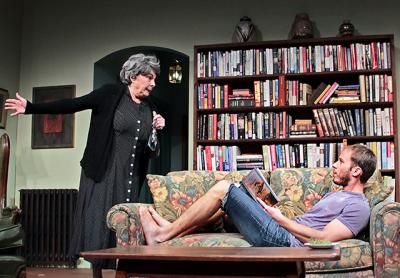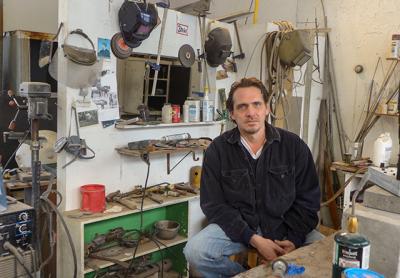The Art Scene: 02.02.17
The Art Scene: 02.02.17
New at Malia Mills
The Winter Salon Series at Malia Mills, a pop-up gallery in the clothing purveyor’s Main Street, East Hampton, space, will open a new group exhibition with a reception Saturday from 6 to 8 p.m. Organized by Folioeast’s Coco Myers and Kay Gibson, the show will run through Feb. 12.
Mary Ellen Bartley will show works from her folded series of book edges, and Carolyn Conrad will be represented by large-format house pieces. Roisin Bateman’s recent paintings continue her exploration of subtle bands of color and line, while Dan Welden’s large prints shimmer with vibrant bursts of color.
Gallery hours are Saturday and Sunday, 11 a.m. to 5 p.m., and by appointment by calling 917-592-8033.
Abstraction at Halsey Mckay
“Flat Fix,” an exhibition of work by 18 artists organized by Ryan Steadman, is on view, by appointment only, at the Halsey McKay Gallery in East Hampton through Feb. 21.
The works in the show reflect the development of abstract painting to the point at which industrial and household materials — among them plastic, rubber, vinyl, and printing ink — are incorporated into artworks. The title reflects the way in which such materials finish, enhance, or improve the flat painted surfaces.
African-American Artists
The Grenning Gallery in Sag Harbor will open “Expanding Tradition: The Journey of the African-American Artist” with a reception Saturday from 5:30 to 7 p.m. The show, which celebrates Black History Month, will run through March 5.
Organized with Andreé MiChelle, a writer from Sag Harbor, the exhibition features the work of seven emerging and midcareer artists who have mastered the classical techniques championed by the gallery over the past 20 years.
The show will include work by Mario Robinson, George Morton, Philip Smallwood, Jas Knight, Roger Beckles, James Hoston, and Irvin Rodriguez. The gallery will host a book signing on Feb. 18 for Ms. MiChelle’s new book, “Escape Under Cover: The Ola Mae Story,” a young-adult novel set during the time of the Underground Railroad.
Victoria Munroe Opens
In Manhattan
Victoria Munroe, an art dealer who opened galleries in New York City and Boston before launching the Drawing Room in East Hampton with Emily Goldstein in 2004, has opened Victoria Munroe Fine Art on Manhattan’s Upper East Side.
The gallery will present exhibitions of modern and contemporary art, often juxtaposed with historical works on paper. The next show, which will open Wednesday and continue through April 1, will feature sculpture by Costantino Nivola and paintings on paper by Antonio Asis.
Works by both artists have been exhibited at the Drawing Room, which is open by appointment only through March.
Jeff Muhs in Chelsea
“Supernature,” an exhibition of paintings by Jeff Muhs, will open today at the Lyons Wier Gallery in Chelsea and continue through Feb. 25. A reception will be held tonight from 6 to 8.
Mr. Muhs, a painter, sculptor, and designer who lives in Southampton, will show layered works that begin with the application of black oil paint over a prepared surface. He then applies opaque areas of color to the canvas, creating a push and pull between background and foreground and a dialogue between dense areas of color and churning areas of black and white.
Stacked Images in Sag
The John Jermain Memorial Library in Sag Harbor will present “Transasia Stacks,” a show of photographs by Gerald Pryor, from Tuesday through Feb. 28, with a reception set for Feb. 11 from 3 to 5 p.m.
According to the photographer, who has owned a house in Sag Harbor since 1986 and has visited China annually since then, “Stacks are two to three still photographic images placed on top of each other. At times they are distinct, at times they blur and merge.” The stacked photographs from Sag Harbor and China result in images that transcend both locations.
“50 Shades of White”
The Art Gallery at the Quogue Library is presenting “50 Shades of White,” a juried photography show that celebrates the beauty of white in all its permutations. On view through Feb. 26, the photographs, by 23 East End photographers, will be judged by Neil Watson, director of the Long Island Museum and formerly director of the Katonah Museum of Art in Westchester County. Prizewinners will be announced at a reception on Saturday from 3 to 4:30 p.m.





